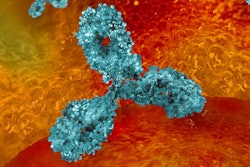
A new alpha-radioimmunotherapy agent, Pb-212-anti-CD38, prevented tumor growth and increased survival in multiple myeloma tumor-bearing mice, according to new research published in the Journal of Nuclear Medicine.
Given the radiopharmaceutical's long half-life, centralized production, and worldwide distribution, researchers said it could be clinically feasible as a multiple myeloma treatment.
The research team led by Isabelle Quelven-Bertin at Limoges University Hospital in Limoges, France, developed human myeloma cell lines that were analyzed for cell proliferation after incubation with various concentrations of Pb-212 monoclonal antibodies. The team grafted human myeloma cell lines subcutaneously into rats and injected them with Pb-212-anti-CD38, Pb-212-anti-mCD38 (mice-specific), or Pb-212-isotypic control.
Quelven-Bertin and colleagues performed biodistribution, toxicity, and dose-range-finding studies, as well as radioimmunotherapy experiments that measured tumor volume and overall survival. They found cell proliferation was significantly inhibited in the human myeloma cell line three days after incubation with Pb-212-anti-CD38 (Journal of Nuclear Medicine, July 2020, Vol. 61:7, pp. 1058-1065).
Similarly, the mouse model also showed cell proliferation inhibition when treated with Pb-212-anti-CD38, with a median survival of 55 days. The isotypic control had a median survival of 11 days. Toxicity experiments with Pb-212-anti-mCD38 established a toxic activity of 277.5 kBq.
However, the researchers were not able to perform whole-body SPECT/CT using Pb-212 due to the low activity of the radioelement and instead used Pb-203, which is chemically identical.
The alpha-radioimmunotherapy drug allowed researchers to consider a theranostic approach and prevented the need for a radionuclide with different physical-chemical properties that would likely result in different pharmacokinetics, according to the authors.
"Combining therapy and imaging could provide an effective approach to optimizing therapeutic doses using specific dosimetry calculation and to monitoring the patient's response," said co-author Dr. Michel Cogné, PhD, professor of immunology at Limoges Medical School in Limoges. "Moving forward, this could be considered as an innovative theranostic approach."



















